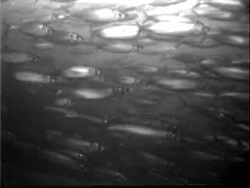Nekton

Under nekton (from Greek νηκτόν nekton “the swimming”, “the swimming power”) one understands the “swimming world”, ie the entirety of the pelagic animals in oceans and inland waters , which is capable of a controlled horizontal movement, that is to an active, current independent swimming . The adjective has to be formed from the root of the word ( nekt -) and is therefore correctly “nectic”, but the form “nectonic” is also found in scientific literature. The term "Nekton" was introduced in 1890 by Ernst Haeckel .
introduction
A body of water can be divided into different habitats ( biotopes ): The Benthal , i.e. the ground or bank area and the adjoining zone of free water, the pelagic . The inhabitants of the pelagial can be divided into two groups according to their degree of mobility.
The necton represents one part of the biological community ( biocenosis ) in the pelagic, i.e. the area remote from the shore and the ground. The other part of this community is the living world of the plankton , whose organisms, apart from some giant forms ( mega (lo) plankton ), mostly are significantly smaller and, above all, weaker. Therefore, if they are able to do so at all, they are only able to make an insignificant movement of their own and thus not to move horizontally in a targeted manner. In contrast to the more powerful and agile Nekton, they are fully subject to the forces of the water currents .
The nekton represents the vast majority of the top-tier consumers of the food web in the respective biotope . Some organisms, mostly in the sea, change between habitats in the course of their development. These organisms, known as meroplankton , only belong to the plankton with their pelagic drift stages (eggs, larvae); later they adopt a benthic (e.g. mussels) or nectic way of life (in many fish species).
Nectic organisms

In addition to vertebrates (fish, marine mammals and reptiles, as well as some aquatic bird species), only two other phyla , the arthropods (long-tailed decapods (Decapoda)) and the molluscs ( Coleoidea ( cephalopods )) have produced nectic forms. The size spectrum ranges from the centimeter range - the so-called micronecton of 2 to 20 cm is of particular importance here - to the approximately 30 m long blue whale . The fish of fresh and sea water occupy a dominant position within the necton. They form the most species-rich group ( taxon ) and, together with the cephalopods, form the largest part of the biomass of the necton.
The nekton is extraordinarily diverse and occurs in all climates . The following is an overview with examples from different pelagic zones and zoogeographical regions. It should be noted that living beings are considered marine if they are predominantly in the marine environment and at the same time are part of the marine food chain. Polar bears, for example, spend most of their lives on the sea ice . As they are also excellent swimmers, they are also part of the Nekton.
In the sea
- Mollusks (dibranchiate cephalopods ( Coleoidea ), e.g. the pearl boat Nautilus spec. )
- Crustaceans (a few species of the long-tailed decapods belonging shrimp are nektisch)
- Vertebrates
- Round mouths ( hagfish , lampreys )
- Fish (examples: tuna , whale shark , mackerel )
- Reptiles ( sea turtles , sea snakes , sea iguanas , saltwater crocodiles )
- Birds (examples: penguins , guillemots , boobies )
- Marine mammals ( whales , seals , sea otters , manatees , polar bears )
In inland waters
- Vertebrates
- Round mouth ( brook lamprey )
- fishes
- Amphibians
- Reptiles (examples: aquatic turtles , crocodiles )
- Birds (examples: cormorant , loons )
- Mammals (examples: beavers , otters , river dolphins, and several species of actual dolphins that also ascend rivers)
Adjustments
Most nectic species are predatory carnivores . This way of life requires the ability to move quickly and a series of corresponding analogous adaptations which developed independently of one another ( convergence ) in the different taxa in the course of their tribal history ( evolution ). Such adaptations to fast swimming represent the development of a streamlined body to reduce the flow resistance and thus the friction . For rapid progress, fish and whales have developed unpaired fins (caudal fin / fluke ), as well as a stabilizing (dorsal fin / fin ) and paired pectoral fins that are used for control. In contrast , the inhabitants of the benthal , the benthos , are often slower, because their prey consists primarily of slowly moving or sessile organisms that are stuck to the substrate .
See also: ecosystem , lake ecosystem
Web links
Individual evidence
- ↑ Stefan Nehring and Ute Albrecht (1997): Benthos and the redundant benthon: Neologisms in German-speaking limnology. In: Lauterbornia H. 31: 17–30, Dinkelscherben, December 1997 E-Text (PDF file; 212 kB) ( Memento of the original from May 9, 2016 in the Internet Archive ) Info: The archive link was inserted automatically and has not yet been checked . Please check the original and archive link according to the instructions and then remove this notice.
